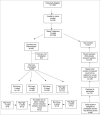School-based HPV immunization of young adolescents: effects of two brief health interventions
- PMID: 25692717
- PMCID: PMC4514159
- DOI: 10.1080/21645515.2014.1004022
School-based HPV immunization of young adolescents: effects of two brief health interventions
Abstract
Adolescent immunization rates for human papillomavirus (HPV) are low and interventions within school-based health centers (SBHCs) may increase HPV uptake and series completion. We examined the effect of a parent health message intervention on HPV vaccination intent, first dose uptake and series completion among adolescents who received care at SBHCs. Via computer-assisted telephone interviews (CATI), 445 parents of young adolescents were randomly assigned to 2 two-level interventions using a 2 × 2 design (rhetorical question (RQ) or no-RQ and one-sided or two-sided message). The RQ intervention involved asking the parent a question they were likely to endorse (e.g., "Do you want to protect your daughter from cervical cancer?") with the expectation that they would then behave in a manner consistent with their endorsement (i.e., agree to vaccinate). For the one-sided message, parents were given information that emphasized the safety and effectiveness of HPV vaccine, whereas the two-sided message acknowledged that some parents might have concerns about the vaccine, followed by reassurance regarding the safety and effectiveness. At CATI conclusion, parents indicated intentions to have their adolescents vaccinated. Parents who endorsed any intent were sent a consent form to return and all adolescents with signed returned consents were vaccinated at SBHCs. Medical records were reviewed for uptake/completion. Parents were 87% female; adolescents were 66% male and racially/ethnically diverse. 42.5% of parents indicated some intention to immunize, 51.4% were unsure, and 6.1% were not interested. 34% (n = 151) of adolescents received their first dose with series completion rates of 67% (n = 101). The RQ component of the intervention increased intention to vaccinate (RR = 1.45; 95%CI 1.16,1.81), but not first dose uptake or series completion. The 1-sided and 2-sided messages had no effect. This brief, RQ health intervention enhanced intent, but did not impact vaccination rates, likely due to the time delay between the intervention and consent form receipt.
Keywords: CATI, computer-assisted telephone interviews; HPV vaccination; HPV, human papillomavirus; HPV4, quadrivalent human papillomavirus vaccine; RQ, rhetorical question; SBHC; SBHC, School-based health center; THC, Teen Health Center; UTMB, University of Texas Medical Branch; brief health messages; immunization; intervention.
Figures
References
-
- Schmidt MA, Gold R, Kurosky SK, Daley MF, Irving SA, Gee J, Nateway AL. Uptake, coverage and completion of quadrivalent human papillomavirus vaccine in the vaccine safety datalink, July 2006- June 2011. J Adolesc Health 2013; 53:637-641; PMID:24138765; http://dx.doi.org/10.1016/j.jadohealth.2013.08.002 - DOI - PMC - PubMed
-
- Curtis RC, Yankey D, Jeyarajah J, Dorell C, Stokeley S. MacNeil J, Hariri S. National and state vaccination coverage among adolescents aged 13-17 years—United States, 2012. MMWR 2013; 62:685-693; PMID:23985496 - PubMed
-
- Fu LY, Bonhomme LA, Cooper SC, Joseph JG, Zimet GD. Educational interventions to increase HPV vaccination acceptance: A systematic review. Vaccine 2014; 32:1901-20; PMID:24530401; http://dx.doi.org/10.1016/j.vaccine.2014.01.091 - DOI - PMC - PubMed
-
- Holman DM, Benard V, Roland KB, Watson M, Liddon N, Stokley S. Barriers to human papillomavirus vaccination among US adolescents: a systematic review of the literature. JAMA Pediatrics 2013; 168:76-82; http://dx.doi.org/10.1001/jamapediatrics.2013.2752 - DOI - PMC - PubMed
-
- U. S. Department of Commerce United States Census Bureau. Enrollment status of the population 3 years old and over, by sex, age, race, Hispanic origin, foreign born, and foreign-born parentage: October 2012. Available at http:\\www.census.gov/hhes/school/data/cps/2012/tables.html. [Accessed May 2014]
Publication types
MeSH terms
Substances
Grants and funding
LinkOut - more resources
Full Text Sources
Other Literature Sources
Medical


